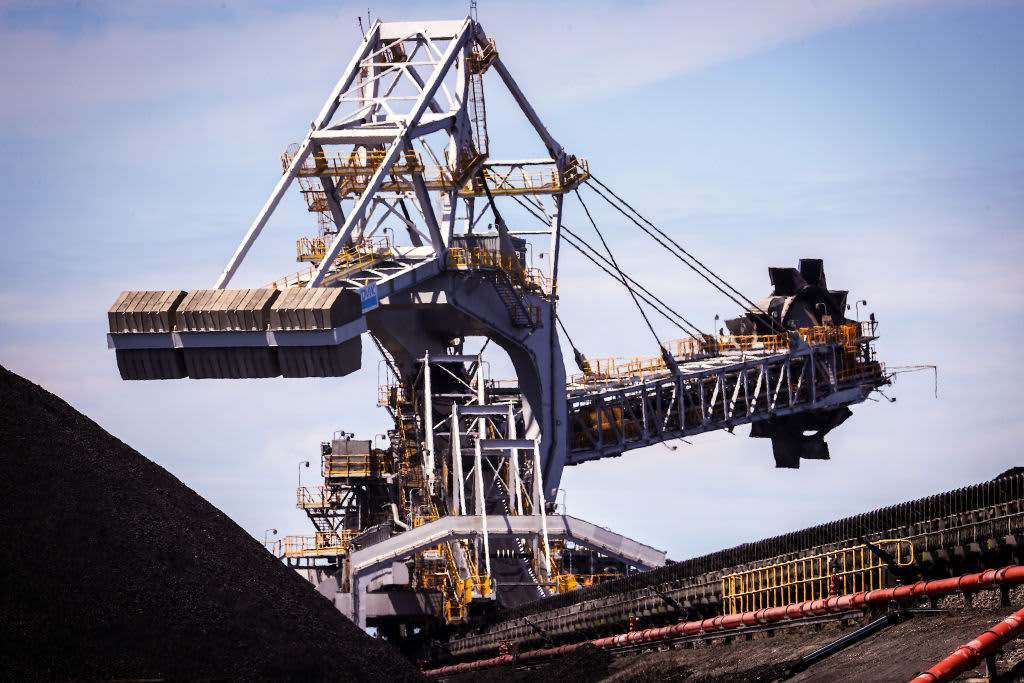
A bucket-wheel reclaimer stands next to a piles of coal at the Newcastle Coal Port, in Newcastle, New South Wales, Australia, on Oct. 12, 2020.
David Gray | Bloomberg | Getty Images
Wide restrictions that China slapped on Australian exports are not as damaging as it was feared they’d be, because Australia is finding new markets for its goods.
Tensions between the countries have soared in recent months, deteriorating sharply after Australia supported a call for a global inquiry into China’s early handling of Covid-19.
Beijing has since taken several measures restricting Australian imports, ranging from levying tariffs to imposing other bans and restrictions. That has affected Australian goods including barley, wine, beef, cotton and coal.
Collectively, the targeted exports were worth about $25 billion in 2019, or 1.3% of Australia’s gross domestic product, according to Australia-based Lowy Institute.
Australia is one of the few developed countries in the world that has enjoyed a trade surplus with China. With China being Australia’s largest trading partner, analysts expected Australia to be hit badly by the restrictions.
But those analysts now say Australia has managed to contain the damage by diverting many of its exports to other countries.
Australian coal exporters seem to have been quite successful in diverting to other markets.
Roland Rajah
lead economist, Lowy Institute
“Exports to China have predictably collapsed in the areas hit by sanctions, but most of this lost trade seems to have found other markets,” said Roland Rajah, lead economist at the Lowy Institute.
Overall, the affected Australian exports to China — except for coal — held steady through most of 2020 to the tune of just over $9 billion, Rajah said. They eventually dropped to about half that amount as restrictions escalated in late 2020, he added.
Following the restrictions, those same goods found other export markets, and trade rose by about $4.2 billion in annualized terms for those goods, offsetting most of the losses from China, according to Rajah.
Sectors thriving: coal, timber, seafood
Coal is one of the commodities that’s thriving despite China’s ban.
“Australian coal exporters seem to have been quite successful in diverting to other markets,” Rajah said in a recent note. “Exports to other markets initially rose as China first reduced its coal imports in general starting around mid-year. The trend then accelerated as China targeted Australian coal specifically starting in October 2020.”
By January 2021, Australian coal exports to the rest of the world were running $9.5 billion higher in annualized terms than before the ban, he said.
Notably, Australian coal in India has been gaining market share, according to Rajah.
Marcel Thieliant, senior Australia and New Zealand economist, concurred.
While Australia’s non-iron ore exports to China have slumped by 40% over the past year, “coal miners have been able to divert their shipments to other countries,” he said. “The upshot is that the conflict isn’t as damaging to Australia’s economy as many think.”
We are always looking as well at other opportunities that we can pursue, whether it be through our existing trading partners or by opening up new avenues to be able to explore.
Dan Tehan
Australian trade minister
It isn’t just coal. Other Australian exports hit by those restrictions show “even clearer signs of substantial trade diversion,” said Rajah.
He listed barley, cotton, seafood and timber which managed to find new markets.
“Sales of these products to other markets rose sharply, but only after China’s sanctions intensified in late 2020 — with the stark shift signaling this was indeed mostly a result of trade diversion.”
Sectors hurting: beef, wine
The analysts noted, however, that Australia has had difficulties shipping off beef and wine.
“Australia’s wine industry has struggled to make up for the loss of the premium China market,” Rajah noted. Earlier this year, China imposed anti-dumping duties on some Australian wines, claiming that Australia has been dumping and subsidizing its wine exports — and hurting China’s domestic wine sector as a result.
Beef was also hit, when China suspended imports from some Australian beef suppliers.
But both Rajah and Thieliant say the slowdown in exports may not just be due to trade tensions with China — it may be largely attributed to supply issues after the recent drought too.
“It’s also striking that copper exports haven’t risen much even as the price of copper has risen by a third relative to pre-virus levels,” Thielant told CNBC. “That also suggests that Australia has had difficulties in shipping copper elsewhere.”
But Australia is not sitting back. It’s on a hunt for new markets as tense relations with China show no signs of abating.
Its deputy prime minister, Michael McCormack, told CNBC in May that the country was looking to diversify its markets.
As an example, he said Australia had just sent its first shipment of barley to Mexico.
Beijing slapped antidumping and anti-subsidy duties on Australian barley last year — a move that effectively shut the country’s barley producers out of the Chinese market.
Last week, Australia’s trade minister said it will ask the World Trade Organization to establish a dispute settlement panel to resolve concerns about such restrictions imposed on Australian barley by China.
Australia’s Trade Minister Dan Tehan told CNBC on Wednesday that his country is also considering whether to get the WTO involved in the ongoing wine dispute with China.
Tehan echoed the message that Australia is looking at ways to find new markets for its products. It is currently negotiating a free trade agreement with the United Kingdom and the European Union.
“We are always looking as well at other opportunities that we can pursue, whether it be through our existing trading partners or by opening up new avenues to be able to explore,” he added.




